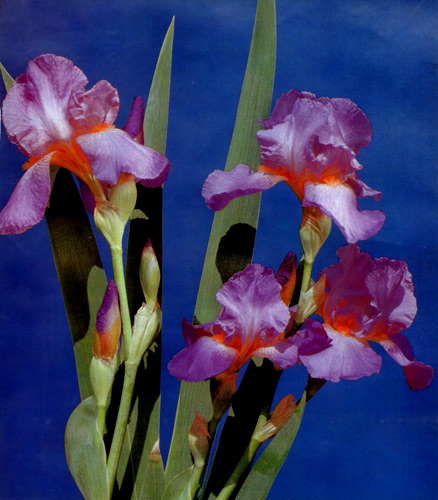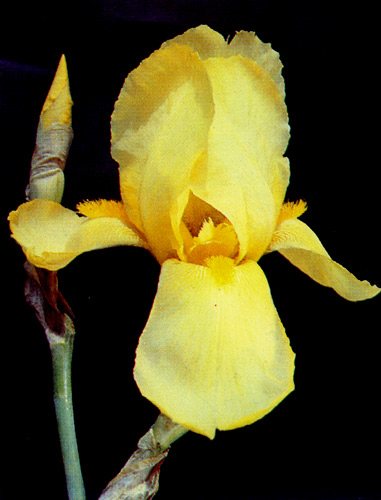
Regelia iris
Iris of this comparatively small but very interesting section have received their name in memory of Edward Regel, a prominant Russian botanist, Director of the Botanical Gardens in St. Petersburg. He had contributed greatly to the studies of the flora of our country and described over 1,000 new species which considerable number is included into the golden stock of decorative plants.

56. 'Serenada'
The nucleus of the section comprises iris growing in the mountains of Central Asia, these are: Iris korolkowii, Iris stolonifera, Iris hoogiana and Iris afganica. The features common to all these iris are narrow sward-like leaves fading soon after flowering has finished, large brown pear-shaped caruncles and arrow-shaped flower stalks bearing two blooms. In the first three species flower stems are up to 45-60 cm high, and in I. afganica do not exceed 20—25 cm.

57. 'Andrej Kniazev'
The blooms of each species have their own typical features. In Iris korolkowii they represent a rare natural model. The falls and standarts have a bright net of scarlet-red veins on a light background.
The blooms of Iris afganica are still more unusual: the blades of the falls are striped in fantastic design with orange-red veins and the standards gleam green and yellow. The blooms of Iris stolonifera that thrive in the mountains stretching between the cities of Dushanbe and Samarkand, vary in colour from bronze-brown to pale-or dark-violet or different bluish shades, but are always marked by reddish-bronze petal margins.
All the three species are of interest for hybridization as well as for growing in the open. However, they can be cultivated only in the regions with dry and hot summer. In the northern regions, such as, for instance, located at the latitude of Leningrad, the iris suffer from insufficient sun warmth and excess of moisture and are generally lost in two or three years after planting.

58. 'Nadezhdy'
Iris hoogiana is the only tolerant species suitable for growing in the north-western regions of the European part of the USSR. It is characterized by very large sky-blue flowers with an unusually strong fragrance. Even at the latitude of Leningrad it grows better if at least partly shaded by shrubs or trees. Its flowering begins earlier than in Iris germanica varieties and the flowers are good for cutting, it overwinters in Leningrad without protection. The upper part of the rhizome may be frozen only in very cold and snowless years. Annual adding of soil is necessary to cover the rhizomes as they badly withstand drying out when emerge above the soil surface. The plants are insufficiently tolerant of winds.
This species may play an important role in advancing to the North the species of the sections Regelia and Oncocyclus.

59. 'Zoloto Kanady'
|
ПОИСК:
|
© FLOWERLIB.RU 2001–2022
При использовании материалов активная ссылка обязательна:
http://flowerlib.ru/ 'Библиотека по цветоводству'
При использовании материалов активная ссылка обязательна:
http://flowerlib.ru/ 'Библиотека по цветоводству'